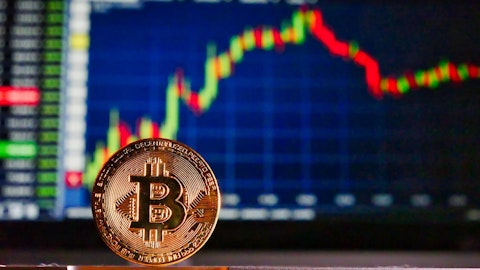In this article, we will take a look at the 12 best low cost ETFs. If you want to skip our discussion on trends amongst low-cost ETFs, you can check out the 5 Best Low Cost ETFs.
With over 8,000 stocks listed across all US equity markets, identifying the right stocks can be a difficult task for investors. This is where exchange-traded funds (ETFs) come into play, offering diversified market coverage at a low cost. According to the iShares division of BlackRock, ETFs represent 12.6% of equity assets and 2.7% of fixed-income assets in the US. During the second quarter of 2023, the average daily trading volume of US equity ETFs was valued at $141.6 billion, contributing to 28% of the overall total trading volume of the US equity markets.
According to one of the leading associations of regulated funds in the US, the Investment Company Institute (ICI) has observed an average decline of 53% in the expense ratio of equity exchange-traded funds and a reduction of 56% in the expense ratio of average index bond ETFs between 2009 and 2022. The industry body has cited higher intensity of competition and economies of scale as the primary reasons for the decline in expense ratios. As per the ICI, the average expense ratio of index equity ETF saw a contraction of one basis point in 2022 to 0.16%. Meanwhile, the average expense ratio of index bond ETFs also fell by one basis point to 0.11% in 2022. The widespread popularity of ETFs can be gauged by the fact that the number of ETFs increased from 204 in 2005 to 2,844 in 2022, while the total net assets rose from $301 billion to $6.48 trillion. The total net assets of ETFs were at an all-time high of $7.19 trillion in 2021. However, global financial markets took back some of their gains in 2022 due to rising inflation and global uncertainty. Overall, Equity ETFs are the most popular type of ETF, as they accounted for 78% of the total net assets at the end of 2022. You can also check out the 12 Best Growth ETFs to Buy here.
ETFs like SoFi Select 500 ETF (NYSEARCA:SFY), BNY Mellon US Large Cap Core Equity ETF (NYSEARCA:BKLC), JPMorgan BetaBuilders U.S. Equity ETF (CBOE:BBUS), SPDR Portfolio S&P 500 ETF (NYSEARCA:SPLG) and iShares Core S&P 500 ETF (NYSE:IVV) each offer distinct approaches to tracking the S&P 500 index. These ETFs provide coverage to large and mega-cap companies such as Apple Inc. (NASDAQ:AAPL), Microsoft Corporation (NASDAQ:MSFT), and Amazon.com, Inc. (NASDAQ:AMZN), which represent nearly 80% of the US equity market. Meanwhile, SPDR Portfolio S&P 1500 Composite Stock Market ETF (NYSEARCA:SPTM) tracks the S&P Composite 1500 index that covers 90% of the US equity markets. The common theme for all these low-cost ETFs is that they are based on passive, market cap-weighted indexing of the broad US stock market. Investors often favor low-cost index fund ETFs over mutual funds due to their cost-effectiveness and tax efficiency. Additionally, there is an ongoing debate in the investment world regarding the outperformance of passive funds compared to active funds.

Photo by AlphaTradeZone
Our Methodology
In this article, we have shortlisted the 12 best low-cost ETFs for 2023 based on their expense ratios. Additionally, we considered ETFs with a 5-year price performance exceeding 50% to ensure the selection of high-quality options. SoFi Select 500 ETF (NYSEARCA:SFY) is the only ETF under $50 on our list. Furthermore, Vanguard Total Stock Market Index Fund (NYSEARCA:VTI) and Vanguard 500 Index Fund (NYSEARCA:VOO) are amongst the low-cost Vanguard ETFs included in our selection. Some of these ETFs can be regarded as the best low-cost index funds for 2023, as these ETFs track the same indexes that the index funds track. The ETFs have been ranked in descending order of their expense ratios as of September 25.
12 Best Low Cost ETFs
12. Vanguard 500 Index Fund (NYSEARCA:VOO)
5-Year Price Performance: 50.1%
Total Net Assets as of September 25, 2023: $908.43 billion
Expense Ratio: 0.04%
Number of Holdings: 506
Vanguard 500 Index Fund (NYSEARCA:VOO) tracks the S&P 500 Index, which covers around 500 of the largest US stocks. As an index fund, the Vanguard 500 Index Fund (NYSEARCA:VOO) uses a passive management strategy and full replication approach, meaning it holds all 500 stocks in the index at their market cap weights. It is the biggest ETF on our list of the best low cost ETFs in terms of net assets and is also considered one of the biggest ETFs globally.
11. Vanguard Growth Index Fund (NYSEARCA:VUG)
5-Year Price Performance: 73.9%
Total Net Assets as of September 25, 2023: $182.53 billion
Expense Ratio: 0.04%
Number of Holdings: 234
Vanguard Growth Index Fund (NYSEARCA:VUG) follows the CRSP US Large Cap Growth Index, which includes large-cap US stocks that exhibit growth characteristics. The ETF employs a passive management strategy designed to closely match the risk and return characteristics of the growth index. As a growth index fund, Vanguard Growth Index Fund (NYSEARCA:VUG) has a bias towards stocks with higher growth rates and momentum, such as those belonging to the tech, healthcare, and consumer discretionary sectors. Vanguard Growth Index Fund (NYSEARCA:VUG) is considered to be one of the biggest growth index funds in the world.
10. Schwab U.S. Broad Market ETF (NYSEARCA:SCHB)
5-Year Price Performance: 43.7%
Total Net Assets as of September 25, 2023: $23.46 billion
Expense Ratio: 0.03%
Number of Holdings: 2465
Schwab U.S. Broad Market ETF (NYSEARCA:SCHB) tracks the Dow Jones U.S. Broad Stock Market Index, which represents the broadest index of the US equity market. The ETF includes stocks across all market capitalizations, offering a high level of diversification. Schwab U.S. Broad Market ETF (NYSEARCA:SCHB) uses a passively managed, full replication strategy to closely track its benchmark index. Apple Inc. (NASDAQ:AAPL), Microsoft Corporation (NASDAQ:MSFT), and Amazon.com, Inc. (NASDAQ:AMZN) are the top three holdings of the ETF with a combined weightage of 14.66% of total assets.
Here’s what Diamond Hill Capital said about Amazon.com, Inc. (NASDAQ:AMZN) in its Q2 2023 investor letter:
“Among our top contributors were insurance company American International Group (AIG), auto retailer CarMax and global online retailer Amazon.com, Inc. (NASDAQ:AMZN).
Amazon’s management team has been working to improve retail profitability, and Q1 results showed progress. In the case of Amazon’s web services (AWS), the market has shifted its focus from where growth will bottom in the near term to how AI can help accelerate the adoption of public cloud services in the future. We believe Amazon’s competitive advantages will continue to grow and that the business has the potential to grow faster than the overall economy in the coming years.”
9. iShares Core S&P Total U.S. Stock Market ETF (NYSEARCA:ITOT)
5-Year Price Performance: 44.1%
Total Net Assets as of September 25, 2023: $45.63 billion
Expense Ratio: 0.03%
Number of Holdings: 2829
iShares Core S&P Total U.S. Stock Market ETF (NYSEARCA:ITOT) is developed to follow the S&P Total Market Index, which represents the entire US equity market, including micro, small, mid, large, and mega-cap stocks. iShares Core S&P Total U.S. Stock Market ETF (NYSEARCA:ITOT) has the second-highest number of holdings amongst all the ETFs that made it to our list of the best low cost ETFs. Healthcare, technology, and financial services are the top three sector holdings of iShares Core S&P Total U.S. Stock Market ETF (NYSEARCA:ITOT). Together, these sectors represent 53.35% of the total assets.
8. Vanguard Total Stock Market Index Fund (NYSEARCA:VTI)
5-Year Price Performance: 44.6%
Total Net Assets as of September 25, 2023: $1.37 trillion
Expense Ratio: 0.03%
Number of Holdings: 3803
Vanguard Total Stock Market Index Fund (NYSEARCA:VTI) tracks the performance of the CRSP US Total Market Index, representing the entire US equity market. This ETF has the highest number of holdings amongst all the ETFs on our list. Vanguard Total Stock Market Index Fund (NYSEARCA:VTI) uses a passively managed index sampling approach to replicate the performance of the benchmark index. In terms of net assets, Vanguard Total Stock Market Index Fund (NYSEARCA:VTI) ranks as the biggest low-cost ETF on this list and is also considered one of the largest ETFs globally.
7. Schwab U.S. Large-Cap ETF (NYSEARCA:SCHX)
5-Year Price Performance: 47.8%
Total Net Assets as of September 25, 2023: $34.02 billion
Expense Ratio: 0.03%
Number of Holdings: 756
Schwab U.S. Large-Cap ETF (NYSEARCA:SCHX) tracks the performance of the Dow Jones US Large-Cap Total Stock Market Index, which focuses on large-cap US stocks. It includes stocks representing the top 90% of market capitalization in the Dow Jones US Total Stock Market Index. The fund uses a full replication approach, meaning it holds every stock in its benchmark index. Schwab U.S. Large-Cap ETF (NYSEARCA:SCHX) offers a straightforward way to invest in the US large-cap market at a very low cost.
6. SPDR Portfolio S&P 1500 Composite Stock Market ETF (NYSEARCA:SPTM)
5-Year Price Performance: 47.9%
Total Net Assets as of September 25, 2023: $6.76 billion
Expense Ratio: 0.03%
Number of Holdings: 1509
SPDR Portfolio S&P 1500 Composite Stock Market ETF (NYSEARCA:SPTM) tracks the S&P 1500 Composite Stock Market Index, which combines the S&P 500 large-cap index with the S&P MidCap 400 and S&P SmallCap 600 to encompass the entire US equity market. SPDR Portfolio S&P 1500 Composite Stock Market ETF (NYSEARCA:SPTM) provides extremely diversified exposure to US stocks across various size and style segments. SPDR Portfolio S&P 1500 Composite Stock Market ETF (NYSEARCA:SPTM) uses a sampling strategy to replicate the index performance.
Click to continue reading and see the 5 Best Low Cost ETFs.
Suggested articles:
- 14 Best Basic Materials Stocks To Buy Now
- 14 Best Dividend Kings Stocks to Buy Now
- 12 Best Bank Stocks To Buy For Long-Term
Disclosure: None. 12 Best Low Cost ETFs is originally published on Insider Monkey.





